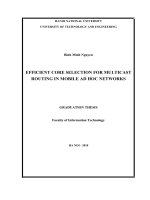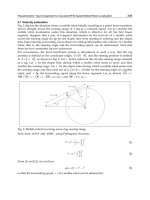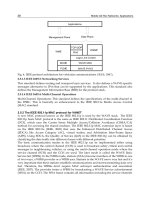Mobile Ad Hoc Networks Applications Part 12 ppt
Bạn đang xem bản rút gọn của tài liệu. Xem và tải ngay bản đầy đủ của tài liệu tại đây (596.67 KB, 35 trang )
2 Theory and Applications of Ad Hoc Networks
destinations that need another description should be assigned the second video description,
and so on. The main d ifference between Sequential MDC and C entralized MDC algorithms is
that the former d oes not employ the independent-property of MDC.
We evaluate and compare our proposed algorithms under different network conditions. For
example, network size, and multicast group size. Simulation results demonstrate that, indeed,
the way of multicast trees construction and the assignment of MD video can greatly affect
the user satisfaction. In addition, simulation results show that MDC can achieve higher
user satisfaction compared to Layered Coding (LC) with a small cost in terms of number
of pure forwarders nodes, bandwidth utilization, and aggregate tree delay. Furthermore,
simulation results show that the independent-description property of MDC can increase the
user satisfaction.
The rest of this chapter is organized as follows. In the next section, we present the related
work. In section 3, we present our network model and problem formulation of video
multicasting. In Section 4, we describe our proposed algorithms for constructing multiple
node-disjoint multicast trees and assigning MD video. In Section 5, we evaluate our proposed
algorithms. The complexity analysis of the protocols is presented in Section 6. Finally, our
conclusions are presented in Section 7.
2. Re lated work
An ad hoc network is a multihop wireless network without a preinstalled infrastructure
or centralized administration. It can be deployed in situations where infrastructure is
unavailable or where temporary network is needed. In this network, nodes are free to move
randomly anytime, anywhere, and arrange themselves as required. Since nodes are often
not within the radio transmission range of each other, each node operates not only as a
host but also as a router, forwarding packets for other mobile nodes. In a typical ad hoc
environment, mobile nodes work as a group to accomplish a certain task. Hence, multicast
is very useful and efficient means of supporting group-oriented applications. Multicast is
an essential technology for many applications such as video distribution and group video
conferencing, and results in bandwidth and power savings as compared to multiple unicast
sessions.
Many researches over the last several years have focused on unicast and
multicast video transmission over wireless ad hoc networks (Wei & Zakhor,
2007; Mao, Cheng, Hou & Sherali, 2006; Agrawal et al ., 2006; Chow & Ishii, 2008;
Mao, Hou, Cheng, Sherali, M idkiff & Zhang, 2006; Mao et al., 2003). The main objective
of these researches is to improve the quality of the received video by exploiting the error
resilience properties of MDC along with multiple paths. In other words, MD video are
encoded and transmitted over different paths to each destination node. If only any path is
broken, packets corresponding to the other descriptions on the other paths can still arrive at
the destination node o n time.
MDC has been proposed as an alternative of the LC (Layered C oding) technique. In contrast
to LC, MDC is a coding technique which fragments a single media stream into independent
bit-streams, where the multiple bit-streams are referred to as multiple descriptions. In
order to decode the media stream, any description can be used (we referred to as
”independent-description” property (Badarneh et al., 2008)); however, the quality improves
with the number of descriptions received in parallel. The idea of MDC is to provide error
resilience to media streams. Since an arbitrary subset of descriptions can be used to decode the
original stream, network congestion or packet loss, which is common in best-effort networks
376
Mobile Ad-Hoc Networks: Applications
Multiple Multicast Tree Construction and Multiple Description Video Assignment Algorithms 3
such as the Internet, will not interrupt the stream but only cause a temporary loss of quality.
The quality of a stream can be expected to be roughly proportional to data rate sustained by
the receiver (Goyal, 2001; Puri & Ramchandran, 1999).
Video multicast over wireless ad hoc networks with path diversity has been studied in
Wei & Zakhor (2007); Mao, Cheng, Hou & Sherali (2006); Agrawal et al. (2006); Chow & Ishii
(2008). Chow and Ishii have proposed a multicast protocol for video transmission called
MT-MAODV (Multiple Trees Multicast Ad Hoc On-demand Distance Vector) (Chow & Ishii,
2008). An extension to the well-knownMAODV to construct two optimally disjoint multicast
trees in a single routine for video multicast was proposed. MDC scheme is used to
split the video into several independent and equally important video descriptions. Each
description is transmitted over different tree. In (Mao, Cheng, Hou & Sherali, 2006), the
authors introduced a multicast approach for multiple description video over ad hoc networks.
An application-centric, cross-layer r outing approach with the objective of minimizing the
over all video distortion was proposed. In this approach multiple source trees for MD video
multicast are used. Furthermore, each description is coded into a base layer and number
of enhancement layers. Packets belonging to the same description from both the base layer
and enhancement layers are transmitted on the same tree. The authors showed that this
approach can effectively deal with frequent link failures and diverse link qualities in wireless
ad hoc networks. Agrawal et al. have presented a multiple tree protocol called Robust
Demand-driven Video Multicast Routing (RDVMR) (Agrawal et al., 2006). RDVMR explores
the path diversity and error resilience properties of MDC. RDVMR deploys a novel path based
Steiner tree heuristic to reduce the number of forwarding nodes in each tree, and constructs
multiple trees in parallel with a reduced number of common nodes among them to provide
robustness against path breaks and to reduces the total data overhead. Two multiple tree
multicast routing protocols were presented in (Wei & Zakhor, 2007). Serial MDTMR protocol
(Multiple Disjoint Trees Multicast Routing) constructs two disjoint multicast trees in a serial
fashion. However, in order to reduce routing overhead and construction delay of serial
MDTMR, parallel MNTMR (Multiple Nearly-disjoint Trees Multicast Routing) was suggested.
This protocol constructs two nearly-disjoint multicast trees in a single routine by dividing
the network virtually into two parts and tree construction is carried out simultaneously at
both virtual topologies. Both serial MDTMR and parallel MNTMR protocols explore MDC
to provide robustness for video multicast applications. In order to improve the quality of the
received video, the video was split into two descriptions and each description was transmitted
over a different tree.
3. Network model and problem formulation
3.1 Network model for multicasting
We consider a multi-hop wireless ad hoc network with V nodes. The n odes communicate
with each other via wireless links. Each node in the network can communicate directly with
a subset of the other nodes in a network. A node v can transmit directly to node u if the both
nodes are within the transmission range of each other. We modeled a wireless ad hoc network
as weighted
G =(V, E ),whereV is a set of wireless nodes each with random location and E
is a set of wireless communication links between the nodes. A link between node pair
{
v, u
}
indicates that both nodes v and u are within each other’s transmission range. The nodes in set
V can be of the following three types:
– Multicast source node: The node that sends out the multicast video packets. We denote it
by
S.
377
Multiple Multicast Tree Construction and Multiple Description Video Assignment Algorithms
4 Theory and Applications of Ad Hoc Networks
– Destination node: A node that receives the multicast video packets. The set o f destination
nodes in a multicast tree is denoted by
Y⊆V−S
– Forwarder node: A node that is an intermediate hop in the path from the source S to a
destination node in
Y. It is denoted by F.
Two positive real-valued functions are defined on a link e
=
{
v, u
}
∈E
,namely:
– Link Delay: d
(e) ∈
+
.
– Link Bandwidth: Bw
(e) ∈
+
.
In this work, we focus on the network layer, i.e., the construction of multiple multicast trees
and the assignment of MD video. We assume that the physical and MAC layers dynamics,
such as the link delay and bandwidth, are translated into the network layer parameters.
These parameters can be measured at every n ode and distributed through the network using
LSAs (Link State Advertisements) (Clausen & Jacquet, year 2003).
D
EFINITION 1: A path p from the multicast source S to a destination node in G is defined as a list
of nodes
(v
1
,v
2
,···, v
k
) such that ∀ j,1 ≤ j ≤ k,e
j
=(v
j
,v
j+1
) ∈Eand no node appears more than
once.
The delay of the path p is the sum o f all link delays, that is,
d
(
p
)
=
k−1
∑
j=1
d
e
j
(1)
The bandwidth of the path p is the minimum available bandwidth of all links, which is defined
as
Bw
(p )=min
e
i
∈p
{
Bw
(
e
i
)}
(2)
In case of
K node-disjoint paths, P =
{
p
1
, p
2
,···, p
K
}
, then the delay of the K paths for a
destination node is:
d
(P)=max
p
j
∈P
d
p
j
(3)
Let L be the number of the multicast trees constrcuted to meet the destinations’ requirments,
then the delay of the tree-aggregate T
= t
1
∪ t
2
∪···t
L
is defined as:
d
(T)= max
l∈
|
1 L
|
d(t
l
) (4)
where d
(t
l
) is the delay of a multicast tree t
l
, which is defined as the longest delay from the
source
S to the destinations o n t
l
,thatis:
d
(t
l
)=max
p
i
∈t
l
{
d(p
i
)
}
, i =
|
1 m
|
(5)
where m is the number of destinations o n t
l
.
378
Mobile Ad-Hoc Networks: Applications
Multiple Multicast Tree Construction and Multiple Description Video Assignment Algorithms 5
3.2 Problem formulation
Our problem of MD video assignment can be formulated as follows: Given a wireless ad hoc
network
G =(V, E),withN number of MD video, a link delay, a link bandwidth, a source
S, and a set of destinations Y =
{
R
1
, R
2
,···, R
m
}
such that each destination node R
i
∈Y
requires a preference number of MD video, then construct multiple node-disjoint multicast
tree spanning
Y∪Ssuch that the total number of the assigned video descriptions to each
destination is maximized. That i s:
maximize
N
asg
(R
i
)
(6)
where
N
asg
(
R
i
)
is the number of the assigned video descriptions to the destination R
i
.
To minimize the delay of every path from the source
S to each destination R
i
∈Y, the shortest
path tree algorithm is deployed.
4. Multiple multicast tree construction and multiple description video assignment
algorithms
4.1 Serial MDC algorithm
The MD video assignment and multiple multicast trees construction algorithms are shown
in algorithms 1
− 4. At the beginning, let the multicast source has a partial topology that
contains multiple paths to each destination, as shown in Fig. 1(a). Following, it arranges the
destinations that require one and two video descriptions in a descending order according to
their number of node-disjoint paths in the sets x and y, respectively. After that, it checks the
destinations in the set y if any of them has only one path, if yes, i t adds it to the set x.Atthe
end of these steps, the sets x and y contain the destinations arranged in a descending order
according to their number of p aths. After that, the source node runs the algorithms 1
− 4. We
use the two colors: red and green to refer to the first and second descriptions, respectively.
The multicast source starts with the set y and constructs its red (R) and green (G) paths for
each destination if possible. To find the R-path, the green nodes (G-nodes) should be removed
because they already have been assigned a description and they cannot be on another tree.
However, to find the G-path, the red nodes ( R-nodes) should be removed. The R and G paths
are constructed using shortest path algorithm (in terms of delay).
When the set y is empty, the source node starts with the set x. Since any description can
reproduce the original video signal, this, what we referred to as independent-description
property of MDC, therefore the multicast source will assign any color (R or G) to each
destination in the set x.
Based on the sets of multiple paths
K
R
i
(the R and G paths) for every destination R
i
, then t he
multicast s ource S constructs multiple multicast trees for the video transmission according
to algorithm 4. That is, all nodes that have been assigned the same color are attached to the
same tree. For example, the no des that have been assigned the R-color are attached to the first
tree (R-tree) and the nodes that have been assigned the G-color are attached t o the second tree
(G-tree). Fig. 1 is an illustrative example.
4.2 Distributed MDC algorithm
In this algorithm the assignment of MD video and the construction of multiple multicast
trees are performed in a distributed manner. Each node in the network will only select one
video description to transmit it to its neighbor nodes. This condition is to ensure disjointness
between multicast trees. Destination nodes are responsible to construct multiple node-disjoint
paths to the multicast source, node S . Each destination node will select a number of disjoint
379
Multiple Multicast Tree Construction and Multiple Description Video Assignment Algorithms
6 Theory and Applications of Ad Hoc Networks
5
6
:
%
=
&
5
5
:
%
5
5
6
:
%
=
&
5
5
=
&
5
66
5
6
:
%
=
&
5
5
5SDWK 5QRGHVUHPRYDO *SDWK
ED
:
%
*QRGHVUHPRYDO
5
5SDWK
6
6
:
%
=
&
5
5
5
=
&
5
6
5QRGHVUHPRYDO
*SDWK
F
G
:
%
5
=
&
5
5
5
6
6
H
5WUHH
*WUHH
5HG *UHHQ
Fig. 1. Serial MDC: An illustrative example: (a) Partial topology. (b) Multiple paths
construction and nodes removal for destination R
2
. (c) Multiple paths construction and
nodes removal for destination R
1
. (d) Multiple paths construction and nodes removal for
destination R
3
. (e) Multiple multicast trees construction.
paths equal to its preference number of MD video. If there are two paths have the same video
description, the one with shortest delay will be chosen.
The source node
S will broadcasts the information of the available MD video and the
bandwidth requirements for each description to its neighbor nodes. Neighbor nodes that
have enough bandwidth will randomly choose one description and rebroadcasts it along
with its bandwidth requirement to its neighbor nodes. As we mentioned previously, each
node will only choose one description to transmit it to its neighbor nodes to maintain
disjointness between multicast trees. This process will continue to reach a destination node.
380
Mobile Ad-Hoc Networks: Applications
Multiple Multicast Tree Construction and Multiple Description Video Assignment Algorithms 7
Algorithm 1 Serial M DC
1: Given: G =
(
V, E
)
,setx,andsety
2: for ∀ i ∈ set y do
3: Z=sety
4: Construct a R
path
using algorithm 2
5: Construct a G
path
using algorithm 3
6: end for
7: for ∀ k ∈ set x do
8: Z=setx ∪ set y
9: Construct a R
path
using algorithm 2
10: if the R
path
= φ then
11: Construct a G
path
using algorithm 3
12: end if
13: end for
When a d estination node receives information about a video description, it will rebroadcast
this information to its neighbor nodes. This means also that a destination node could be
a forwarder node. If this destination node has enough bandwidth it will select another
description to receive. After a destination node selects its proper paths it will send this
information to the source node.
After the multicast source
S receives the paths for each destination node, it constructs multiple
node-disjoint multicast trees. To do so, nodes that have the same video description s h ould be
added to the same tree. Algorithm 5 describes the construction of multiple multicast trees.
Fig. 2 shows an example of MD video assignment and construction of multiple multicast
trees. The multicast source S broadcasts information about two video d escriptions ( VD
1
,and
VD
2
) to its neighbor nodes, nodes W ,andZ. Each node will randomly select one video
description to rebroadcast. Therefore, node W selects VD
1
and node Z selects VD
1
.After
that, nodes W and Z will rebroadcast this information to their n eighbors nodes, nodes B,and
C. This process will continue until this information reached the destination nodes, nodes
R
1
, R
2
,andR
3
. Destination nodes R
1
,andR
3
will select the paths S → W → B → R
1
,and
S
→ Z → C → R
3
, respectively, to receive VD
1
. The destination node R
2
hastwopathswith
the same description, description VD
1
. Therefore, it will select the path with minimum delay.
Assume the path S
→ W → B → R
2
is selected. Note that destination node R
2
receives the
same video description through different paths. This can be related to the randomness of
choosing a video description. Finally, the multicast source S will construct only one multicast
tree using algorithm 5. Fig. 2(c) shows multicast tree t
1
.
Algorithm 2 R
path
Construction
1: for ∀ jG
path
∈ Z do
2: P = Parents of G
nodes
3: V←V- P
4: end for
5: Construct a R
path
using the shortest path (in terms of delay) algorithm
381
Multiple Multicast Tree Construction and Multiple Description Video Assignment Algorithms
8 Theory and Applications of Ad Hoc Networks
Algorithm 3 G
path
Construction
1: for ∀ jR
path
∈ Z do
2: P = Parents of R
nodes
3: V←V- P
4: end for
5: Construct a G
path
using the shortest path (in terms of delay) algorithm
5
6
:
%
=
5
5
D
&
^9'
9'
`
^9'
9'
`
^9'
`
^9'
`
^9'
`
^9'
`
^9'
`
^9'
`
5
6
:
%
=
5
5
E
&
^9'
`
^9'
`
^9'
`
^9'
`
^9'
`
^9'
`
^9'
`
5
6
:
%
=
5
5
F
&
5RXWH5HTXHVW
5RXWH5HSO\ 0XOWLFDVWWUHHOLQN
Fig. 2. Distributed MDC algorithm: (a) Route Request broadcasts. (b) Route Reply unicast.
(c) Multicast tre e construction.
Algorithm 4 Serial MDC: Multiple Multicast Tree Construction
1: Given:Z=setx ∪ set y
2: for ∀ i ∈ Z do
3: if i has R
col or
then
4: Add i to R
tree
5: else if i has G
col or
then
6: Add i to G
tree
7: end if
8: end for
382
Mobile Ad-Hoc Networks: Applications
Multiple Multicast Tree Construction and Multiple Description Video Assignment Algorithms 9
Algorithm 5 Distributed MDC: Multiple Multicast Tree Construction
1: for i = 1 to V do
2: if no de i has the 1
st
video description then
3: Add node i to tree t
1
4: else
5: Add node i to tree t
2
6: end if
7: end for
4.3 Centralized MDC a lgorithm
Before the construction of multiple node-disjoint multicast trees and the assignment of MD
video, the multicast source S starts with constructing individual Multiple Node-Disjoint
Paths (MNDP), with minimum delay, to each destination in the multicast group to meet the
number of video descriptions required.
D
EFINITION 1: MNDP problem: consider a network represented by a graph G =(V, E ) and a
bandwidth constraint
W, find a MNDP, set P
i
, from the multicast source node S to the destination
node R
i
such that:
1. d
p
ij
is minimized,
∀ p
ij
∈ P
i
2. Bw
p
ij
≥W, ∀ p
ij
∈ P
i
Algorithm 6 describes how MNDP are constructed. Before constructing multiple nodedisjoint
paths to each destination, we first remove all links with capacity less than the bandwidth
requirement, and then we construct multiple shortest paths (in terms of delay) on the
residual network. Based on the sets of MNDP constructed, then multicast heuristic algorithm
constructs Multiple Node-Disjoint Multicast Trees (MNDMT) for the video transmission, as
shown in Algorithm 7.
Algorithm 6 Multiple Node-Disjoint Paths
1: P
i
= φ /* MNDP set */
2: For each destination R
i
do
3: Let G
∗
be equal to G
4: repeat
5: Find a shortest path p
ij
to R
i
(in terms of delay) in G
∗
such that Bw
p
ij
≥W
6: Add p
ij
to P
i
7: Remove all forwarding nodes of p
ij
in G
∗
8: until
The number of paths in P
i
equal to the number of video descriptions required
As a simple example, we consider the partial network topology in Fig. 3(a), with a
requirement of two descriptions for destination R
2
and one description for both destinations
R
1
and R
3
, to demonstrate the construction of multiple multicast trees. According to
Algorithm 6, there are three path sets (Fig. 3(b)) P
1
, P
2
,andP
3
from the source S to the
destinations R
1
, R
2
,andR
3
,whereP
1
=
{
p
11
}
=
{
S → W → B → R
1
}
, P
2
=
{
p
21
, p
22
}
=
{
S → W → B → R
2
,S → Z → C → R
2
}
,andP
3
=
{
p
31
}
=
{
S → Z → C → R
3
}
.
383
Multiple Multicast Tree Construction and Multiple Description Video Assignment Algorithms
10 Theory and Applications of Ad Hoc Networks
In Fig. 3(c)-(e), we show an example of multiple multicast trees construction using MNDMT.
According to Algorithm 7, Step 4, the destination R
2
has the maximum number of paths,
which is set P
2
, (two paths); therefore we have two multicast trees according to step 5, namely,
t
1
= p
21
and t
2
= p
22
as seen in Fig. 3(c). The path p
11
of the destination R
1
will be added to
t
1
(Fig. 3(d)), according to Step 8, since it intersects t
1
with the most links. Because P
1
= φ,
then the algorithm picks up the next destination, R
3
, and adds its path p
31
to tree t
2
(Fig.
3(e)) according to Step 8. Since all the paths of each destination have been added, then the
algorithm ends.
After constructing multiple multicast trees, Algorithm 8 assigns different video description
to each tree. Therefore, trees t
1
and t
2
are assigned the first and second descriptions,
respectively. Since any description can reproduce the original video signal, this we referred
to as independent-description property of MDC, therefore the destination R
3
will be able to
reproduce the original video signal. It is worth noting that if LC technique is used instead of
MDC and according to Chen-LC al gorithm, only one multicast tre e will be constructed. Thus,
they will be only assigned the basic layer.
4.4 Sequential MDC algorithm
Sequential algorithm constructs multiple disjoint multicast trees and assigns MD video to the
destination nodes in a centralized fashion. However, the main difference between sequential
MDC and centralized MDC algorithms is that the assignment of MD video is executed in a
sequential way. This means that all the destination nodes should be first assigned the first
video description (VD
1
), then the destination nodes that require a second description they
will be assigned the second video description (VD
2
) and the destination nodes that require
a third description they be assigned the third video description (VD
2
) and so on. Therefore,
to perform the assignment of MD video in a sequential way, the destination nodes on each
multicast tree should be superset of the later, i.e., t
L
⊆ t
L−1
··· ⊆ t
2
⊆ t
1
. Algorithm 7 is
deployed to construct multiple disjoint multicast trees, and then algorithm 9 is executed to
form the final version of the multiple multicast trees. After that, the trees t
1
,t
2
,···, t
L
will be
assigned the first, the second and the L
th
description, respectively. It is worth pointing out
that Sequential MDC algorithm d oes not employ t he independent-property of MDC.
Algorithm 7 Multiple Node-Disjoint Multicast Trees
1: for i = 1 to m do
2: Find the set of MNDP P
i
by algorithm 6
3: end for
4: Find a set P
i
that has the maximum number o f paths
5: initially, Let T = P
i
, i.e., t
1
= p
i1
, t
2
= p
i2
, , t
L
= p
iL
6: for i = 2 to m do
7: Add e ach path in P
i
to T as follows:
8: Find a path p
ij
∈ P
i
such that it intersects a tree t
k
⊂ T not covering R
i
with the most
links, and add p
ij
to t
k
t
k
← t
k
+ p
ij
9: Remove p
ij
from P
i
P
i
← P
i
− p
ij
10: Repeat Steps (8) and (9) until P
i
= φ
11: end for
384
Mobile Ad-Hoc Networks: Applications
Multiple Multicast Tree Construction and Multiple Description Video Assignment Algorithms 11
W
W
W
W
5
6
:
%
$GGSDWKS
WRW
$GGSDWKS
WRW
E
F
H
G
5
3
5
=
&
5
3
3
6
:
%
6
=
&
6
5
6
:
%
5
5
=
&
5
=
&
5
6
:
%
6
5
6
:
%
5
6
5
=
&
W
W
5
6
:
%
5
6
5
=
&
D
5
Fig. 3. Centralized MDC algorithm
We use Fig. 3(a), to explain how sequential MDC algorithm constructs multiple disjoint
multicast trees. At the end of algorithm 7, two d isjoint multicast trees are constructed, namely,
t
1
and t
2
as seen in Fig. 3(e). However, in order to perform sequential assignment of MD
video, R
3
should be connected to t
1
. And because Sequential MDC al gorithm maintains totally
385
Multiple Multicast Tree Construction and Multiple Description Video Assignment Algorithms
12 Theory and Applications of Ad Hoc Networks
Algorithm 8 MD video assignment
1: For i = 1 to L /*L is the number of the multicast trees constructed*/
2: For j = 1 to n /*n is t he number of MD video, (L ≤ n)*/
3: If Bw
(
t
i
)
≥
Bw
(
VD
i
)
then
VD
i
→ t
i
disjoint multicast trees, therefore, only one multicast tree, t
1
, is constructed as shown in Fig.
4.
5
6
%
5
:
5
&
=
W
Fig. 4. Demonstration of sequential MDC algorithm
5. Performance evaluation
This section deals with the performance evaluation of our developed algorithms. In particular,
we evaluate the performance of our proposed algorithms, namely, Serial MDC, Distributed
MDC, Centralized MDC, and Sequential MDC algorithms and compare them with the
algorithm proposed by Chen et al. in (Chen et al., 2004). Chen et al. proposed this algorithm
for assigning a number of video layers that are encoded using LC technique; we referred to
as Chen-LC. To make a fair comparison, we modified Chen-LC algorithm to construct node
disjoint multicast trees. Moreover, in order to take the bandwidth requirements for MDC
and LC into consideration, we consider the video sequences reported in (Gogate et al., 2002).
Since all the video sequences have roughly the same bit rate, we consider the video sequence
of ”Football”. The average video source rate is 1.5 Mbps for each description, whereas the
average video source rate for the layered coder is 1.57 Mbps for the base layer a nd 1.45 Mbps
for the enhancement layer.
We generate a wireless ad hoc network by placing a number of nodes at random locations
in a square area of 1000
× 1000 m
2
. The radio transmission range is 250 m and the number
of video descriptions r equired by each destination is uniformly distributed to be
∈
{
1,2
}
.
The residual bandwidth of each link is randomly chosen from
[2, 10] Mbps. The delay in
eachlinkisrandomlychosenfrom
[1, 20] ms. Moreover, the multicast source S and a set of
destinations
Y are randomly chosen from the network graph to form a multicast session. Any
Algorithm 9 Sequential algorithm
1: for i = 1 to L do
2: t
L
⊆ t
L−1
···⊆t
2
⊆ t
1
3: end for
386
Mobile Ad-Hoc Networks: Applications
Multiple Multicast Tree Construction and Multiple Description Video Assignment Algorithms 13
destination node is at least 2-hop away from the multicast source. For each simulation, several
experiments have been run to ensure 95% confidence interval. The 95% confidence intervals
are always plotted, when they are not visible it means that they are smaller than the curve
markers.
To show the significance of our developed algorithms, we evaluate and compare its
performance with the well-known multicast algorithm, Chen-LC, using the following metrics:
– User satisfaction: This metric is defined as the total number of the assigned video
descriptions to all destinations divided by the total number of requested video descriptions
by all destinations. This metric presents the effectiveness of a protocol.
U s er s atis faction
=
n
∑
i=1
N
asg
(R
i
)
n
∑
i=1
N
req
(R
i
)
(7)
where
N
asg
(
R
i
)
,andN
req
(
R
i
)
, are the number of the assigned and requested video
descriptions of the destination R
i
respectively, and n is the number of destinations.
– Number of pure forwarders (PF): It is defined as the number of pure forwarders nodes
on the aggregate multicast tree T that are not destinations. This measures the efficiency in
terms of minimizing the number of pure forwarding nodes.
PF
=
V
∑
i=1
I(v
i
) (8)
where
V is the network size and I(v
i
) is defined as:
I
(v
i
)=
1forv
i
∈ T −
{
S, Y
}
0otherwise
– Bandwidth utilization: This metrics defined as the total used bandwidth for the video
distribution tre e(s).
B an d widt h utiliz atio n
=
∑
e∈u
Bw
(
e
)
(9)
where e denotes a link, u is the set of used links, and Bw
(
e
)
denotes the bandwidth devoted
to video distribution in link e.
– Aggregate tree delay: It represents the longest delay from the multicast source s to a
destination node R
i
on the aggregate tree T, as seen in Equ.(4).
5.1 Varying number of multicast destinations
Fig. 5 to Fig. 8 illustrate Serial MDC, Distributed MDC, Centralized MDC, Sequential MDC
and Chen-LC algorithms performance with varying number of multicast destination nodes
while the network size is set to 50 nodes. Fig. 5 shows that Serial MDC, Distributed MDC,
and Centralized MDC algorithms achieve higher user satisfaction compared to Chen-LC
algorithm. This can be related to the independent-description property of MDC. Sequential
MDC and Chen-LC algorithms have the same user satisfaction. This is because Sequential
MDC algorithm does not employ the independent-property of MDC. In this case it is similar
to Chen-LC. In other words, VD
1
is equivalent to the basic layer and VD
2
is equivalent to
the enhancement layer. Serial MDC, Distributed MDC, and Centralized MDC algorithms are
387
Multiple Multicast Tree Construction and Multiple Description Video Assignment Algorithms
14 Theory and Applications of Ad Hoc Networks
well scalable in term of number of destinations. Centralized MDC algorithm achieves a higher
user satisfaction compared to Serial MDC and Distributed MDC algorithms. As the number of
destinations i ncreases, user satisfaction decreases gradually in Serial MDC, Distributed MDC,
and Centralized MDC algorithms. However, the user satisfaction of Chen-LC and Sequential
algorithms decreases sharply as the number of destinations increases. That is, as a result of
the dependent-layer property of LC (for Chen-LC algorithm) and because Sequential MDC
algorithm does not employ the independent-description property of MDC.
Fig. 6 depicts the number of pure forwarders nodes as a function of number of destination
nodes. It can be seen that Centralized MDC has slightly higher number of pure forwarders
nodes compared to the other algorithms. However, Distributed MDC has a lowest number
of pure forwarders nodes. In Fig. 7, we plot the average bandwidth utilization. Clearly, the
bandwidth utilization of Centralized MDC is slightly higher than the bandwidth utilization
of the other algorithms. This is because Centralized MDC requires more number of pure
forwarders, compared to the other algorithms; to constructs multiple node-disjoint trees (see
Fig. 6). However, Distributed MDC requires a minimum bandwidth for video distribution
trees. This is because Distributed MDC has a minimum number of pure forwarders nodes. We
show in Fig. 8 the aggregate tree delay as a function of number of destinations. All algorithms
achieve a comparable delay as compared to each other. As the number of destinations
increases the aggregate tree delay increases. This is because more paths are constructed to
build multiple multicast tree.
5 10 15 20 25
70
72
74
76
78
80
82
Number of Destinations
User Satisfaction (%)
Network size = 50 nodes
Serial MDC
Chen−LC
Centralized MDC
Distributed MDC
Sequential MDC
Fig. 5. User satisfaction versus number of destinations. Network size = 50 nodes
Fig. 9 to Fig.12 illustrate Serial MDC, Distributed MDC, Centralized MDC, Sequential MDC,
and Chen-LC performance with varying number of multicast destination nodes while the
network size is set to 100 nodes. As the network size increase from 50 nodes (Fig. 5) to 100
nodes (Fig. 9), the users satisfaction for all algorithms increases. This is because the number
of nodes in the network increases. As a result, the number of paths to each destination is
388
Mobile Ad-Hoc Networks: Applications
Multiple Multicast Tree Construction and Multiple Description Video Assignment Algorithms 15
5 10 15 20 25
8
8.5
9
9.5
10
10.5
11
11.5
12
12.5
13
Number of Destinations
Number of pure Forwarders
Network size = 50 nodes
Serial MDC
Chen−LC
Centralized MDC
Distributed MDC
Sequential MDC
Fig. 6. Number of pure forwarders ve rsus number of destinations. Network s ize = 50 nodes
increased. Again, Serial MDC, Distributed MDC, and Centralized MDC show good scalability
as the number of destinations increases. As the number of nodes in the network increases
from 50 to 100 nodes, the number of pure forwarders nodes, the bandwidth utilization, and
the a ggregate tree delay (in Fig. 10, Fig. 11, and Fig. 12) are increased compared to Fig. 6, Fig.
7, and Fig. 8, respectively.
5.2 Varying network size
Fig. 13 to Fig. 20 compare Serial MDC, Distributed MDC, Centralized MDC, Sequential MDC,
and Chen-LC performance, with varying number of nodes in the network (network size)
from 50 to 100 nodes, in terms of user satisfaction, number of pure forwarders, bandwidth
utilization, and aggregate tree delay. The number of destinations is set to 10 and 30 nodes.
Centralized MDC achieve a higher user satisfaction (see Fig. 13 and Fig. 17) compared to the
other algorithms. The cost of that is the increase in the number of pure forwarders nodes (see
Fig. 14 and Fig. 18), the bandwidth utilization (see Fig. 15 and Fig. 19), and the aggregate
tree delay (Fig. 16 and Fig. 20). However this cost is still comparable. As the network size
increases, the user satisfaction for all algorithms increases. We related that to the increase in
the number of resources in the network, i.e., number of nodes, and bandwidth. Fig. 16 and
Fig. 20 show that as the network size increases the aggregate tree delay decreases. This is
because more alternate paths (with minimum delay) may e xist.
Comparing Fig. 13 with Fig. 17, we can note that the user satisfaction, for all algorithms,
decreases as the number of destinations increases from 10 to 30 nodes. This because the
number of node-disjoint paths to the destination nodes decreases. Thus, the number of
assigned MD video to each destination decreases.
389
Multiple Multicast Tree Construction and Multiple Description Video Assignment Algorithms
16 Theory and Applications of Ad Hoc Networks
5 10 15 20 25
20
25
30
35
40
45
50
55
60
65
Number of Destinations
Bandwidth Utilization (Mbps)
Network size = 50 nodes
Serial MDC
Chen−LC
Centralized MDC
Distributed MDC
Sequential MDC
Fig. 7. Bandwidth utilization versus number o f destinations. Network size = 50 no des
5 10 15 20 25
46
48
50
52
54
56
58
60
62
Number of Destinations
Aggregate Tree Delay (ms)
Network size = 50 nodes
Serial MDC
Chen−LC
Centralized MDC
Distributed MDC
Sequential MDC
Fig. 8. Aggregate tree delay versus n umber of destinations. Network size = 50 nodes
390
Mobile Ad-Hoc Networks: Applications
Multiple Multicast Tree Construction and Multiple Description Video Assignment Algorithms 17
5 10 15 20 25
78
80
82
84
86
88
90
92
94
Number of Destinations
User Satisfaction (%)
Network size = 100 nodes
Serial MDC
Chen−LC
Centralized MDC
Distributed MDC
Sequential MDC
Fig. 9. User satisfaction versus number of destinations. Network size = 100 no des
5 10 15 20 25
8
10
12
14
16
18
20
22
24
26
Number of Destinations
Number of pure Forwarders
Network size = 100 nodes
Serial MDC
Chen−LC
Centralized MDC
Distributed MDC
Sequential MDC
Fig. 10. Number of pure forwarders versus number of destinations. Network size = 100
nodes
391
Multiple Multicast Tree Construction and Multiple Description Video Assignment Algorithms
18 Theory and Applications of Ad Hoc Networks
5 10 15 20 25
20
30
40
50
60
70
80
90
100
Number of Destinations
Bandwidth Utilization (Mbps)
Network size = 100 nodes
Serial MDC
Chen−LC
Centralized MDC
Distributed MDC
Sequential MDC
Fig. 11. Bandwidth utilization versus number o f destinations. Network size = 100 nodes
5 10 15 20 25
36
38
40
42
44
46
48
50
52
Number of Destinations
Aggregate Tree Delay (ms)
Network size = 100 nodes
Serial MDC
Chen−LC
Centralized MDC
Distributed MDC
Sequential MDC
Fig. 12. Aggregate tree delay v ersus number of destinations. Network size = 100 nodes
392
Mobile Ad-Hoc Networks: Applications
Multiple Multicast Tree Construction and Multiple Description Video Assignment Algorithms 19
50 55 60 65 70 75 80 85 90 95 100
74
76
78
80
82
84
86
88
90
92
94
Network Size
User Satisfaction (%)
Number of destinations = 10 nodes
Centralized MDC
Chen−LC
Serial MDC
Distributed MDC
Sequential MDC
Fig. 13. User satisfaction versus network size. Number o f destinations = 10 nodes
50 55 60 65 70 75 80 85 90 95 100
10
11
12
13
14
15
16
17
18
Network Size
Number of Pure Forwarders
Number of destinations = 10 nodes
Centralized MDC
Chen−LC
Serial MDC
Distributed MDC
Sequential MDC
Fig. 14. Number of pure forwarders versus network size. Number of destinations = 10 nodes
393
Multiple Multicast Tree Construction and Multiple Description Video Assignment Algorithms
20 Theory and Applications of Ad Hoc Networks
50 55 60 65 70 75 80 85 90 95 100
32
34
36
38
40
42
44
46
48
Network Size
Bandwidth Utilization (Mbps)
Number of destinations = 10 nodes
Centralized MDC
Chen−LC
Serial MDC
Distributed MDC
Sequential MDC
Fig. 15. Bandwidth utilization versus ne twork size. Number of destinations = 10 nodes
50 55 60 65 70 75 80 85 90 95 100
38
40
42
44
46
48
50
52
54
56
Network Size
Aggregate Tree Delay (ms)
Number of destinations = 10 nodes
Centralized MDC
Chen−LC
Serial MDC
Distributed MDC
Sequential MDC
Fig. 16. Aggregate tree delay versus network size. Number o f destinations = 10 nodes
394
Mobile Ad-Hoc Networks: Applications
Multiple Multicast Tree Construction and Multiple Description Video Assignment Algorithms 21
50 55 60 65 70 75 80 85 90 95 100
70
75
80
85
90
95
Network Size
User Satisfaction (%)
Number of destinations = 30 nodes
Centralized MDC
Chen−LC
Serial MDC
Distributed MDC
Sequential MDC
Fig. 17. User satisfaction versus network size. Number o f destinations = 10 nodes
50 55 60 65 70 75 80 85 90 95 100
8
10
12
14
16
18
20
22
24
26
28
Network Size
Number of Pure Forwarders
Number of destinations = 30 nodes
Centralized MDC
Chen−LC
Serial MDC
Distributed MDC
Sequential MDC
Fig. 18. Number of pure forwarders versus network size. Number of destinations = 10 nodes
395
Multiple Multicast Tree Construction and Multiple Description Video Assignment Algorithms
22 Theory and Applications of Ad Hoc Networks
50 55 60 65 70 75 80 85 90 95 100
60
65
70
75
80
85
90
95
100
105
Network Size
Bandwidth Utilization (Mbps)
Number of destinations = 30 nodes
Centralized MDC
Chen−LC
Serial MDC
Distributed MDC
Sequential MDC
Fig. 19. Bandwidth utilization versus ne twork size. Number of destinations = 10 nodes
50 55 60 65 70 75 80 85 90 95 100
44
46
48
50
52
54
56
58
60
62
64
Network Size
Aggregate Tree Delay (ms)
Number of destinations = 30 nodes
Centralized MDC
Chen−LC
Serial MDC
Distributed MDC
Sequential MDC
Fig. 20. Aggregate tree delay versus network size. Number o f destinations = 10 nodes
396
Mobile Ad-Hoc Networks: Applications
Multiple Multicast Tree Construction and Multiple Description Video Assignment Algorithms 23
6. Complexity analysis of the algorithms
We analyze the complexity of our proposed algorithms as follows. For Serial MDC, the
shortest path algorithm (Dijkstra’s algorithm) is of complexity O
(|
V
|
log(
|
V
|
)+
|
E
|)
≤ O
V
2
where
|
V
|
and
|
E
|
are the number of nodes and number of wireless communication links
in the partial topology, respectively. Since it iterates
Y times, where Y is the number of
destination nodes. Therefore the complexity is O
V
2
×Y
and finally the algorithm iterates
N
req
(
VD
)
times, where
N
req
(
VD
)
is the total number of required video descriptions for all
destinations. As a result, the complexity of Serial MDC is given by O
V
2
×Y×N
req
(
VD
)
.
For Distributed MDC the complexity is given by O
(
V
)
. Finally, Centralized MDC, Sequential
MDC, and Chen-LC algorithms have the same complexity of Serial MDC algorithm.
7. Conclusion
In this chapter we study the problem of multiple multicast trees construction and
the assignment of MD video. Different algorithms are proposed for that purpose.
These algorithms are: Serial MDC, Distributed MDC, Centralized MDC, and Sequential
algorithms. Serial MDC, Distributed MDC, and Centralized MDC algorithms deploy
the independent-description property of MDC, whereas Sequential MDC algorithm does
not take this property into consideration. Simulation results demonstrate that deploying
this property of MDC along with multiple multicast tree can greatly improve the user
satisfaction. Furthermore, simulation results demonstrate that the way of multiple multicast
tree construction and the assignment of MD vi deo can affect the user satisfaction. In addition,
simulation results show that MDC can achieve higher user satisfaction compared to Layered
Coding (LC) with a small cost in terms of number of pure forwarders nodes, bandwidth
utilization, and aggregate tree delay.
8. References
Agrawal, D., Reddy, T. B. & Murthy, C. S. R. (2006). Robust demand-driven video
multicast over ad hoc wireless networks, 3rd International Conference on Broadband
Communications, Networks and Systems pp. 1–10.
Badarneh, O., Kadoch, M. & Elhakeem, A. (2008). A new approach for the construction
of multiple multicast trees using multiple description video for wireless ad hoc
networks, IEEE Conference on Local Computer Networks pp. 152–159.
Chen, J., Chan, S H. G. & Li, V. O. (2004). Multipath routing for video delivery over
bandwidth-limited networks, IEEE Journal on Selected Areas in Communications
22(10): 1920–1932.
Chow, C O. & Ishii, H. (2008). Multiple tree multicast ad hoc on-demand distance vector
(mt-maodv) routing protocol for video multicast over mobile ad hoc networks,
IEICE-Transactions on Communications E91-B: 428–436.
Clausen, T. & Jacquet, P. (year 2003). Optimized link state routing protocol (olsr).
www.ietf.org/rfc/rfc3626.txt.
Gogate, N., Chung, D M., Panwar, S. & Wang, Y. (2002). Supporting image and video
applications in a multihop radio environment using path diversity and multiple
description coding, IEEE transactions on circuits and systems for video technology
12(9): 777–792.
Goyal, V. K. (2001). Multiple description coding: Compression meets the network, IEEE Signal
Processing Magazine 18: 74–94.
397
Multiple Multicast Tree Construction and Multiple Description Video Assignment Algorithms
24 Theory and Applications of Ad Hoc Networks
Mao, S., Cheng, X., Hou, Y. T. & Sherali, H. D. (2006). Multiple description vi deo multicast in
wireless ad hoc networks, Mobile Networks and Applications 11: 63–73.
Mao, S., Hou, Y., Cheng, X., Sherali, H., Midkiff, S. & Zhang, Y Q. (2006). On routing
for multiple d escription video over wireless ad hoc networks, IEEE Transactions on
Multimedia 8(5): 1063–1074.
Mao, S., Lin, S., Panwar, S., Wang, Y. & Celebi, E. (2003). Video transport over ad hoc
networks: multistream coding with multipath transport, IEEE Journal on Selected
Areas in Communications 21(10): 1721–1737.
Puri, R. & Ramchandran, K. (1999). Multiple description source coding through forward
error correction codes, IEEE Proceedings Asilomar Conference on Signals, Systems, and
Computers pp. 342–346.
Wei, W. & Zakhor, A. (2007). Multiple tree video multicast over wireless ad hoc networks,
IEEE Transactions on Circuits and Systems for Video Technology 17: 2–15.
398
Mobile Ad-Hoc Networks: Applications
Part 4
TCP in Ad Hoc Networks









